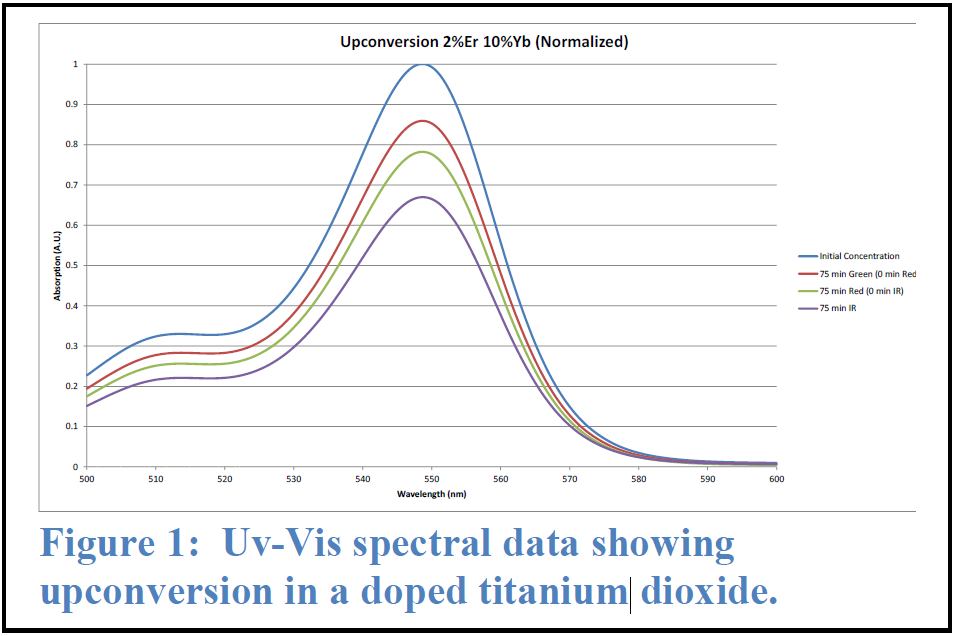Upconversion Photocatalysis for Energy and Environmental Applications
Venkat Bhethanabotla, Professor and Chair
Department of Chemical & Biomedical Engineering
University of South Florida, Tampa, Florida 33620
bhethana@usf.edu;813.974.2116
 Overview of the Bhethanabotla research group: The Bhethanabotla group works in the areas of chemical and biological sensors and systems, plasmonics, and computational catalysis. Sensors research involves utilizing acoustic wave devices, in which piezoelectrically excited elastic waves in solids are perturbed by environmental variables, with suitable electronics utilized to recognize these perturbations. Fundamental studies on understanding the interaction of acoustic waves with sensing layers as well as system aspects of device and micro-fluidics fabrication are addressed in this research. Current emphasis is on the development of point of care biosensors for the detection of biomarkers in bodily fluids directly. Plasmonics research is on the fundamentals of enhancements in fluorescence intensities and photocatalytic rates using nanoparticles and structures with tunable surface plasmon resonance spectra and catalytic properties to achieve these enhancements. Current computational catalysis research utilizes electronic structure calculations to guide design of complex perovskite oxides for solar thermochemical fuel production and photocatalysts for reduction of carbon dioxide and water.
Overview of the Bhethanabotla research group: The Bhethanabotla group works in the areas of chemical and biological sensors and systems, plasmonics, and computational catalysis. Sensors research involves utilizing acoustic wave devices, in which piezoelectrically excited elastic waves in solids are perturbed by environmental variables, with suitable electronics utilized to recognize these perturbations. Fundamental studies on understanding the interaction of acoustic waves with sensing layers as well as system aspects of device and micro-fluidics fabrication are addressed in this research. Current emphasis is on the development of point of care biosensors for the detection of biomarkers in bodily fluids directly. Plasmonics research is on the fundamentals of enhancements in fluorescence intensities and photocatalytic rates using nanoparticles and structures with tunable surface plasmon resonance spectra and catalytic properties to achieve these enhancements. Current computational catalysis research utilizes electronic structure calculations to guide design of complex perovskite oxides for solar thermochemical fuel production and photocatalysts for reduction of carbon dioxide and water.
Teacher Project:
The goal of this project for the teacher is to synthesize rare earth metal doped semiconductors and utilize them in photocatalytic oxidation in model systems. Of the several semiconductors being investigated, oxynitrides are of interest to this project, an example being zinc oxide/gallium nitride. This stable material allows for the tuning of the bandgap in the visible range. Of particular interest is the development of synthesis methods to incorporate rare earth ions, such as erbium and ytterbium, into these lattices. The teacher will develop synthesis methods, and utilize several techniques such as the diffuse reflectance spectroscopy, dynamic light scattering, x-ray diffraction, transmission and scanning electron microscopy, adsorption measurements to characterize the synthesized photocatalysts. These materials will then be utilized in a model photo-oxidation reaction such as the degradation of a dye. A typical environmental pollutant will then be oxidized. The reactions will be studied under various frequencies of light, in the uv, visible and near infrared ranges, to characterize upconversion phenomenon, which is expected to allow for a bigger part of the solar insolation to be utilized to drive the reaction. These studies are expected to lead to better photocatalysts for energy and environmental applications, such as the conversion of carbon dioxide to fuels, and removal of pollutants from water bodies.
All facilities will be in-place for the teacher to start the project immediately. The first few days will be spent on re-reading a few relevant journal articles (which will be provided ahead of time), training on the synthesis method, learning the use of instruments, and discussions with Bhethanabotla. There will be two interns from France and a high-school student working alongside the teacher on related projects, as summer visitors to the lab. Depending upon progress, co-authorship of a conference presentation and a journal article are possible for the teacher, from this project.- 1. Upconversion Photocatalysis for Energy and Environmental Applications
- 2. Sorption of Organic Vapors by Polymers using a Quartz Crystal Microbalance
- 3. Effective Deposition and Spreading of Powder Layers for 3D Printing
- 4. Synthesis and Characterization of Structured Nanomaterials for Energy Applications
- 5. Syntheses and Characterizations of Catalytically Active Porous Metal-Organic Frameworks (MOFs)
- 6. Microfluidic Filtration of Circulating Tumor Cells
- 7. Simulation and Rational Design of Metal-Organic Materials
- 8. Composition of Organic and Inorganic Polymeric Nanofibers for Filtering, Tissue Scaffolding, Wavelength Reflecting, and Self-healing Functionalities
- 9. Dynamic Tissue Cultures for Cell Printing
- 10. Synthesis and Characterization of Nanocomposites for 3D Printed RF Devices